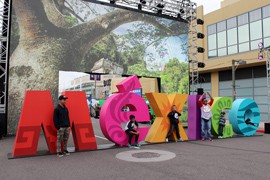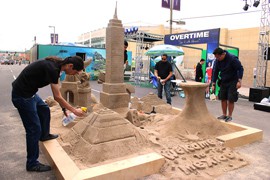Cronkite News has moved to a new home at cronkitenews.azpbs.org. Use this site to search archives from 2011 to May 2015. You can search the new site for current stories.
To promote tourism, Mexico joins celebration of all-American sport
There’s nothing more American than football, as millions upon millions in this country put their lives on hold each year to watch the Super Bowl.
But this time, with the big game in Arizona, Mexico is joining the festivities, including an interactive tourism promotion targeting fans in downtown Phoenix.
Mexico’s government is among the sponsors of Super Bowl XLIX, becoming the first foreign nation to do so, and organizers are expecting tens of thousands of Mexican nationals to join the party. The Super Bowl website, social media and ads are also being written in Spanish for the first time.
Several Mexican cities as well as Mexico’s Tourism Office set up an exhibit called “Live It to Believe It” as part of Super Bowl Central.
It features huge LED screens depicting vibrant Mexican landscapes, a sand sculpture of landmarks and loud, upbeat music. At its opening Wednesday, there were margaritas for the adults and a Formula One race car simulator for the kids. Families could also take a 3-D virtual flight over Mexico City or pose in front of green screens to have their images edited into Mexican parties and beaches.
David Franca, a member of the Arizona Super Bowl Host Committee, said the partnership with Mexico is a win-win.
“Part of the money we have to raise to put the Super Bowl together came from Mexico, which is a huge benefit for us,” he said. “On the Mexico side, they’re promoting Mexico as a country as well, as a tourist destination and a place to do international business. It brings them a completely new fan base they’ve never had before; we expect over a million visitors to Super Bowl Central.”
Farca said this relationship benefits many from Arizona as well.
“Over 30 percent of our population is Hispanic, and a lot of them have that heritage with Mexico,” he said. “They feel integrated and included within the party.”
Roberto Rodriguez, Mexico’s consul general in Phoenix, said he looks forward to what this partnership could mean for the future of Arizona-Mexico relations.
“We are very happy with this atmosphere,” he said. “There are a lot of politicians and people in the business community trying to create a good relationship with Mexico, and we hope we can work together to take advantage of new opportunities and interchange more in the future.”
Mexico is Arizona’s top trading partner, with imports and exports to Mexico making up about 36 percent of Arizona’s foreign exchanges, according to 2013 U.S. Census Bureau reports.
The U.S. also exports its love for football, as Mexico City is estimated to have more NFL fans than Pittsburgh, Seattle and many other American cities with NFL teams, according to Nate Silver of ESPN’s fivethirtyeight.com analysis of NFL-related Google searches.
But Carlos Alsua, lecturer for the International Management and Global Entrepreneurship program at the University of Arizona, said Mexico’s involvement with the Super Bowl is a one-sided contract.
“The advantage for the NFL is opening up their markets to a large population of 110 million people,” he said. “Many of them have a lot of money and disposable income to come and buy NFL paraphernalia and to attend the games. … For Mexico, the U.S. is a big market, but (Mexico) is not something that is as exportable such as Europe and Asia.”
Alsua conceded, though, that Mexico’s “Live It to Believe It” display could have a social impact, if not economic, because it could help to clear away negative stereotypes.
“Countries are brands themselves,” he said. “(The display) is going to improve the Mexican brand in the U.S.”
Hector Morfin, a Mexico City native and producer for the “Live It to Believe It” area of Super Bowl Central, said the goal is highlighting Mexico’s beauty and sophistication.
“I know you all guys see Rocky Point or you go to Tijuana and Baja, but there’s a lot more to it than that,” he said. “I think there’s a lot of stereotypes, which are not bad, but everything is like mariachi, tequila, and this is different. We have very high-end stuff in Mexico. We have a lot more upscale situations going. We have spas. We have first-class resorts. And some people don’t know that.”
Expert opinions aside, visitors to “Live It to Believe It” said they were impressed with the engaging presentation and the way it depicted Mexico’s destinations and culture.
“The booth is just beautiful,” said Ruth Sanchez-Way, 74, who was visiting from Maryland. “It really makes me just feel like I want to go to Mexico.”











